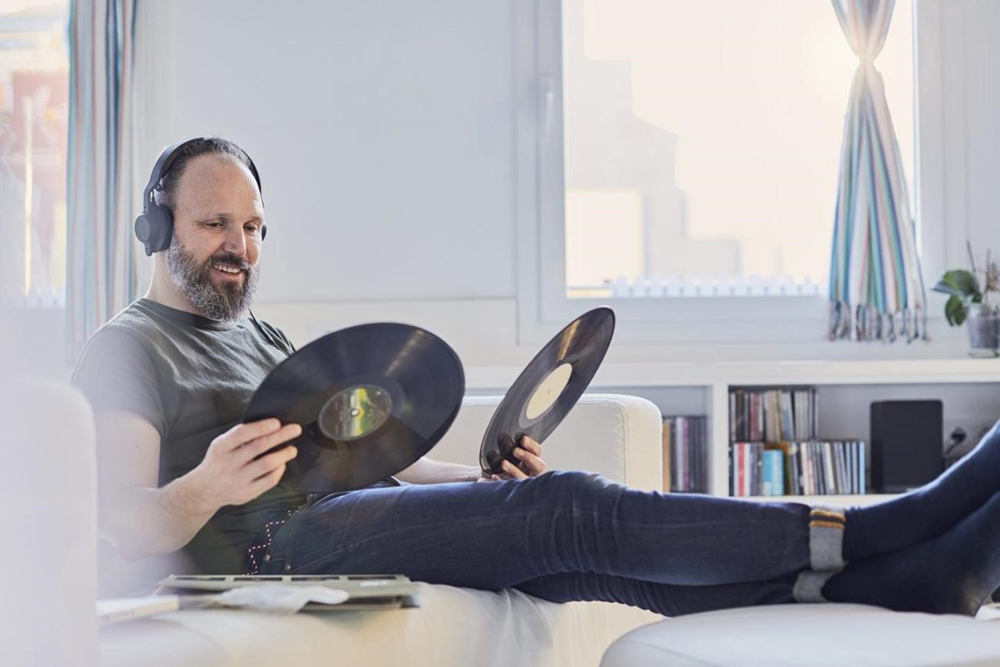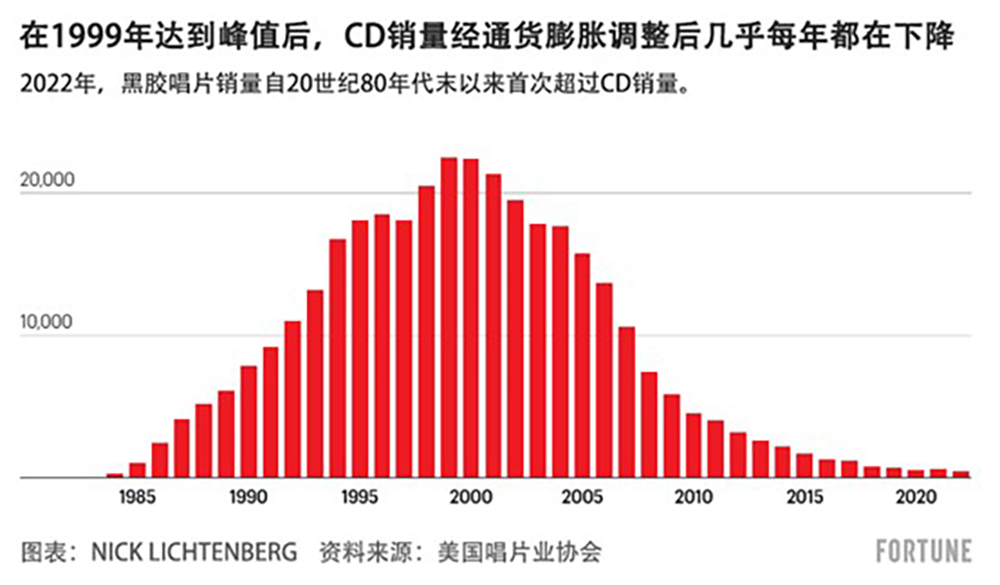
在过去的十年里,黑胶唱片大有东山再起之势。2022年,唱片销售额达到12亿美元,比前一年猛增20%。
美国唱片业协会(Recording Industry Association of America)的一份新报告显示,唱片的销量不仅有所增长,而且自1988年以来首次超过了CD的销量。
谁预见到了这一点?
我显然没有预见到这样的情况会发生。在20世纪90年代中期,不顾妻子的抗议,我变卖了收藏的大量唱片。我劝她说我们需要空间,即使买家以很低的价格(专辑里一首歌的价格)买下了所有藏品。
当然,那时候听音乐的选择要少得多——那是在点播流媒体和智能手机出现之前的几年。
我目前在一所商学院授课,也在关注最新的经济趋势。唱片销量自2007年以来一直在增长,数据显示黑胶唱片行业的反弹仍未见顶。2022年,音乐产业卖出了4,130万张唱片,比1988年以来的任何一年都多。

黑胶唱片复兴只是老技术越来越受欢迎的一个缩影。不仅LP唱片回潮了,20世纪90年代末至21世纪初的手动打字机、棋盘游戏和数码相机也回潮了。
关于唱片为何能够东山再起,有很多说法。
这些说法都忽略了唱片的真正魅力所在。
为什么东山再起的是唱片而不是CD?
一种说法是,婴儿潮一代推动唱片销量大涨,他们中的许多人即将退休,渴望通过唱片勾起怀旧字情,重温年少时光。
数据表明这一说法是不正确的。
首先,目前最畅销的黑胶唱片都是来自当红艺人,而不是经典乐队。在写这篇文章时,成立于20世纪90年代末的乐队街头霸王(Gorillaz)的专辑在黑胶唱片销量排行榜上名列榜首。
其次,来自唱片业的数据显示,最有可能购买LP唱片的人是Z世代——出生于1997年至2012年的人。
另一种说法是唱片很便宜。虽然这在过去可能完全属实,但如今的黑胶唱片却价格不菲。街头霸王乐队的专辑《Cracker Island》目前在黑胶唱片销量排行榜上位居榜首,售价近22美元——是CD价格的两倍。此外,每月花15美元订阅Spotify这样的在线服务,你就可以聆听数百万首歌曲。
第三种说法是人们声称唱片的音质比数字音频文件更好。唱片是模拟录音,能够捕获所有声波。数字音频文件通过周期性地以某一规定间隔截取音频信号(采样),这意味着只可以捕获部分声波。
除了采样之外,许多流媒体服务和大多数存储的音频文件都会压缩录音的声音信息。压缩使人们能够在手机上播放更多的歌曲,并在不占用太多带宽的情况下使用流媒体服务。然而,压缩会消除一些声音。
虽然LP唱片没有经过采样或压缩,但在多次播放后,确实会发出噼啪声和爆裂声。唱片也会出现跳针,这在数字音乐中是不会发生的。
如果你真的追求音质,CD通常是一种音质更优良的数字音乐格式,因为音频数据没有压缩,保真度比唱片好得多。
然而,尽管CD的音质更优良,但CD的销量自2000年达到峰值以来一直在稳步下降。

终极的地位象征
在我看来,一个多世纪前,一位经济学家就指出了唱片复兴最可能的原因。
19世纪90年代末,托尔斯坦·凡勃伦研究了社会消费,写了一本很有影响力的书,题为《有闲阶级论》(The Theory of the Leisure Class)。
在这本书中,他解释说,人们常常把购买商品作为获得荣誉和彰显自己地位的一种方式。凡勃伦的一个关键观点是,人们购买商品并不一定是因为这件商品更容易买到、有趣或质量好。
有时,购买更难买到、更耗时或更稀奇古怪的物品才可以彰显社会地位。
蛋糕就是一个很好的例子。假设你提出要带蛋糕去参加一个聚会。你能够买面包店做出来的、看起来很精美的蛋糕,而且只需几分钟就可以买到。或者你能够在家烤一个。即使它很美味,看起来也不会像面包店做出来的那样精美,而且要花几个小时才可以做好。
但如果你的朋友像我一样,他们就会对自制蛋糕赞不绝口,而不会提及从店里买来的精美蛋糕。
购买和播放黑胶唱片正在成为一种身份的象征。
今天,播放音乐毫不费力。只需对着Siri或Alexa等智能音箱语音点播你想播放的歌曲,或打开智能手机上的应用程序。
在唱片机上播放唱片既费时又费力。建立收藏需要深思熟虑,也需要金钱。一个存储唱片的立柜与配套的唱片机也能够成为品味不俗的客厅摆件。
而现在,我——这个一时冲动的教授——为自己在多年前变卖专辑造成的损失而感到惋惜。(财富中文网)
杰伊·L·扎戈尔斯基(Jay L. Zagorsky)是波士顿大学(Boston University)的临床副教授。
本文已获知识共享(Creative Commons)组织的许可,转载自The Conversation网站。
译者:中慧言-王芳
在过去的十年里,黑胶唱片大有东山再起之势。2022年,唱片销售额达到12亿美元,比前一年猛增20%。
美国唱片业协会(Recording Industry Association of America)的一份新报告显示,唱片的销量不仅有所增长,而且自1988年以来首次超过了CD的销量。
谁预见到了这一点?
我显然没有预见到这样的情况会发生。在20世纪90年代中期,不顾妻子的抗议,我变卖了收藏的大量唱片。我劝她说我们需要空间,即使买家以很低的价格(专辑里一首歌的价格)买下了所有藏品。
当然,那时候听音乐的选择要少得多——那是在点播流媒体和智能手机出现之前的几年。
我目前在一所商学院授课,也在关注最新的经济趋势。唱片销量自2007年以来一直在增长,数据显示黑胶唱片行业的反弹仍未见顶。2022年,音乐产业卖出了4,130万张唱片,比1988年以来的任何一年都多。
黑胶唱片复兴只是老技术越来越受欢迎的一个缩影。不仅LP唱片回潮了,20世纪90年代末至21世纪初的手动打字机、棋盘游戏和数码相机也回潮了。
关于唱片为何能够东山再起,有很多说法。
这些说法都忽略了唱片的真正魅力所在。
为什么东山再起的是唱片而不是CD?
一种说法是,婴儿潮一代推动唱片销量大涨,他们中的许多人即将退休,渴望通过唱片勾起怀旧字情,重温年少时光。
数据表明这一说法是不正确的。
首先,目前最畅销的黑胶唱片都是来自当红艺人,而不是经典乐队。在写这篇文章时,成立于20世纪90年代末的乐队街头霸王(Gorillaz)的专辑在黑胶唱片销量排行榜上名列榜首。
其次,来自唱片业的数据显示,最有可能购买LP唱片的人是Z世代——出生于1997年至2012年的人。
另一种说法是唱片很便宜。虽然这在过去可能完全属实,但如今的黑胶唱片却价格不菲。街头霸王乐队的专辑《Cracker Island》目前在黑胶唱片销量排行榜上位居榜首,售价近22美元——是CD价格的两倍。此外,每月花15美元订阅Spotify这样的在线服务,你就可以聆听数百万首歌曲。
第三种说法是人们声称唱片的音质比数字音频文件更好。唱片是模拟录音,能够捕获所有声波。数字音频文件通过周期性地以某一规定间隔截取音频信号(采样),这意味着只可以捕获部分声波。
除了采样之外,许多流媒体服务和大多数存储的音频文件都会压缩录音的声音信息。压缩使人们能够在手机上播放更多的歌曲,并在不占用太多带宽的情况下使用流媒体服务。然而,压缩会消除一些声音。
虽然LP唱片没有经过采样或压缩,但在多次播放后,确实会发出噼啪声和爆裂声。唱片也会出现跳针,这在数字音乐中是不会发生的。
如果你真的追求音质,CD通常是一种音质更优良的数字音乐格式,因为音频数据没有压缩,保真度比唱片好得多。
然而,尽管CD的音质更优良,但CD的销量自2000年达到峰值以来一直在稳步下降。
终极的地位象征
在我看来,一个多世纪前,一位经济学家就指出了唱片复兴最可能的原因。
19世纪90年代末,托尔斯坦·凡勃伦研究了社会消费,写了一本很有影响力的书,题为《有闲阶级论》(The Theory of the Leisure Class)。
在这本书中,他解释说,人们常常把购买商品作为获得荣誉和彰显自己地位的一种方式。凡勃伦的一个关键观点是,人们购买商品并不一定是因为这件商品更容易买到、有趣或质量好。
有时,购买更难买到、更耗时或更稀奇古怪的物品才可以彰显社会地位。
蛋糕就是一个很好的例子。假设你提出要带蛋糕去参加一个聚会。你能够买面包店做出来的、看起来很精美的蛋糕,而且只需几分钟就可以买到。或者你能够在家烤一个。即使它很美味,看起来也不会像面包店做出来的那样精美,而且要花几个小时才可以做好。
但如果你的朋友像我一样,他们就会对自制蛋糕赞不绝口,而不会提及从店里买来的精美蛋糕。
购买和播放黑胶唱片正在成为一种身份的象征。
今天,播放音乐毫不费力。只需对着Siri或Alexa等智能音箱语音点播你想播放的歌曲,或打开智能手机上的应用程序。
在唱片机上播放唱片既费时又费力。建立收藏需要深思熟虑,也需要金钱。一个存储唱片的立柜与配套的唱片机也能够成为品味不俗的客厅摆件。
而现在,我——这个一时冲动的教授——为自己在多年前变卖专辑造成的损失而感到惋惜。(财富中文网)
杰伊·L·扎戈尔斯基(Jay L. Zagorsky)是波士顿大学(Boston University)的临床副教授。
本文已获知识共享(Creative Commons)组织的许可,转载自The Conversation网站。
译者:中慧言-王芳
Over the past decade, vinyl records have made a major comeback. People purchased US$1.2 billion of records in 2022, a 20% jump from the previous year.
Not only did sales rise, but they also surpassed CD sales for the first time since 1988, according to a new report from the Recording Industry Association of America.
Who saw that coming?
I certainly didn’t. In the mid-1990s, I sold off my family’s very large collection of records over my wife’s protests. I convinced her we needed the space, even if the buyer was picking up the whole stash for a song.
Back then, of course, there were far fewer options for listening to music – it was years before on-demand streaming and smartphones.
I now teach at a business school and follow the economy’s latest trends. Sales of records have been increasing since 2007, and the data shows the vinyl record industry’s rebound still has not peaked. Last year, the music industry sold 41.3 million albums, more than in any year since 1988.
This resurgence is just one chapter in a broader story about the growing popularity of older technologies. Not only are LP records coming back, but so are manual typewriters, board games and digital cameras from the late 1990s and early 2000s.
There are many theories about why records are making a comeback.
Most of them miss the point about their appeal.
Why records and not CDs?
One suggestion is that sales have been spurred by baby boomers, many of whom are now entering retirement and are eager to tap into the nostalgia of their youth.
Data shows this theory is not true.
First, the top-selling vinyl albums right now are current artists, not classic bands. As of this writing, Gorillaz, a band formed in the late 1990s, was at the top of the vinyl charts.
Second, data from the recording industry shows the most likely person to buy a LP record is in Gen Z – people born from 1997 to 2012.
Another theory is that records are cheap. While that might have been true in the past, today’s vinyl records command a premium. “Cracker Island,” the Gorillaz album that is currently topping the vinyl sales charts, lists for almost $22 – twice the cost of the CD. Plus, subscribing to an online service like Spotify for 15 bucks a month gives you access to millions of tracks.
A third explanation for the resurgence is that people claim records have better sound quality than digital audio files. Records are analog recordings that capture the entire sound wave. Digital files are sampled at periodic intervals, which means only part of the sound wave is captured.
In addition to sampling, many streaming services and most stored audio files compress the sound information of a recording. Compression allows people to put more songs on their phones and listen to streaming services without using up much bandwidth. However, compression eliminates some sounds.
While LP records are not sampled or compressed, they do develop snap, crackle and popping sounds after being played multiple times. Records also skip, which is something that doesn’t happen with digital music.
If you’re really going for quality, CDs are usually a superior digital format because the audio data is not compressed and has much better fidelity than records.
Yet even though CDs are higher quality, CDs sales have been steadily falling since their peak in 2000.
The ultimate status symbol
In my view, the most likely reason for the resurgence of records was identified by an economist over a century ago.
In the late 1890s, Thorstein Veblen looked at spending in society and wrote an influential book called “The Theory of the Leisure Class.”
In it, he explained that people often buy items as a way to gain and convey status. One of Veblen’s key ideas is that not everything in life is purchased because it is easy, fun or high quality.
Sometimes harder, more time-consuming or exotic items offer more status.
A cake is a great example. Say you offer to bring a cake to a party. You can buy a bakery-made cake that will look perfect and take only a few minutes to purchase. Or you could bake one at home. Even if it’s delicious, it won’t look as nice and will take hours to make.
But if your friends are like mine, they’ll gush over the homemade cake and not mention the perfect store-bought one.
Buying and playing vinyl records is becoming a status symbol.
Today, playing music is effortless. Just shout your request at a smart speaker, like Siri or Alexa, or touch an app on your smartphone.
Playing a record on a turntable takes time and effort. Building your collection requires thoughtful deliberation and money. A record storage cube alongside an accompanying record player also makes for some nice living room decor.
And now I – the uncool professor that I am – find myself bemoaning the loss of all of those albums I sold years ago.
Jay L. Zagorsky is Clinical Associate Professor, Boston University.
This article is republished from The Conversation under a Creative Commons license.






